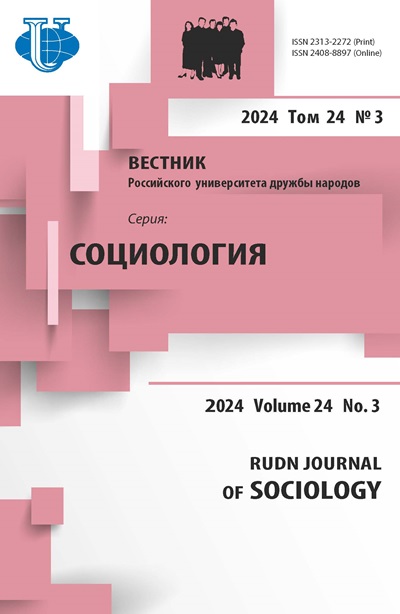Social mechanisms of media institutions: The genesis of recipient’s preferences
- Authors: Mouzykant VL1
-
Affiliations:
- Peoples’ Friendship University of Russia (RUDN University)
- Issue: Vol 17, No 1 (2017)
- Pages: 73-82
- Section: Contemporary society: the urgent issues and prospects for development
- URL: https://journals.rudn.ru/sociology/article/view/15457
- DOI: https://doi.org/10.22363/2313-2272-2017-17-1-73-82
Cite item
Full Text
Abstract
Within the framework of sociology of media the author explains the behavior of target audiences in the nowadays media environment, analyzes the changing nature of the relationship between the sender and the recipient of the message. The article considers the social mechanisms of the contemporary media institutions and changes in media consumption preferences of different social strata under the growing influence of communication technologies. The author believes that the digitalization determines the audience’s need for explanation instead of just information. The virtual reality as a new communication platform becomes a common practice, and the audience becomes its passive participant demanding new ways of real-time access to information. The print media audience is gradually moving from constant reading of one or two mass editions to the study of a large number of specialized media. There is the same trend of the declining share of main television channels in advertising budgets due to the increasing share of specialized network channels. At the same time, advertising budgets are transferred to the mobile platforms for there is a growing need in ‘big data’ in real time due to the fast development of mobile electronic devices. Tablets and smartphones are attributes of the emerging media ecology that are gradually replacing television for digital generations prefer to watch the same TV content ‘outside’ the traditional TV environment.
About the authors
V L Mouzykant
Peoples’ Friendship University of Russia (RUDN University)
Author for correspondence.
Email: vmouzyka@mail.ru
Miklukho-Maklaya St., 6, Moscow, 117198, Russian Federation
References
- Bakhtin M.M. Tvorchestvo Fransua Rable i narodnaja kultura srednevekovja i Re-nessansa [Works of Francois Rabelais and Folk Culture of the Middle Ages and the Renaissance]. Moscow; 1990. (In Russ).
- Budantsev Ju.P. Ocherki nookommunikologii. Massovaja kommunikacija i noosfera [Essays on Communicology. Mass Communication and Noosphere]. Moscow; 1995. (In Russ).
- Budantsev Ju.P. Teorija i praktika zhurnalistiki i massovyh informacionnyh processov [Theory and Practice of Journalism and Mass Information Processes]. Moscow; 1993. (In Russ).
- Homer. Iliad. Available from: http://xwap.me/books/769/Iliada.html?p=83. (In Russ).
- Anderson R., Shihirev P. “Akuly” i “delfiny”». Psihologija i etika rossijsko-amerikanskogo delovogo partnerstva [“Sharks” and “Dolphins”; Psychology and Ethics of Russian-American Business Partnership]. Moscow; 1990. (In Russ).
- Dannye kompanii Gemius [Data of company “Gemius”].
- Dannye kompanii Futuresource Consulting [Data of company “Futuresource Consulting”].
- Dannye kompanii Consumer Centric Consulting i «Pochty Rossii» [Data of companies “Con-sumer Centric Consulting” and “Post of Russia”].
- Kolomiets V.P. Mediasociologija: teorija i pratika [Mediasociology: Theory and Practice]. Moscow; 2014. (In Russ).
- Ljublinskij V.S. Na zare knigopechatanija [At the Dawn of Printing]. Leningrad; 1959. (In Russ).
- Morozova E. “Top-kniga” ushla s dolgami [“Top-book” left with debts]. Vedomosti. 2013 Sept. 17. (In Russ).
- Porshnev B.F. Kontrsuggestija i istorija. Istorija i psihologija [Contrsuggestion and History. History and Psychology]. Moscow; 1971. (In Russ).
- Rossijskaja periodicheskaja pechat'. Sostojanie, tendentsii i perspektivy razvitija [Russian Peri-odicals. Status, Trends, and Prospects for the Development]. Moscow; 2015. (In Russ).
- Toporov V.N. O rituale. Vvedenie v problematiku [On the ritual. An introduction]. Ar-haicheskij ritual v fol'klornyh i ranneliteraturnyh pamjatnikah. Moscow; 1988. (In Russ).
- Berger A.A. Signs in Contemporary Culture: An Introduction to Semiotics. N.Y.; 1984.
- Boorstin D.G. Advertising and America Civilization. In Advertising and Society. Y. Brozen, editor. N.Y.;1974.
- Chronicle of America. N.Y.;1995.
- DeVito J.A. Messages. Building Interpersonal Communications Skills. N.Y.;1990.
- Greenberg C. Avant-Garde and Kitsch. Partisan Review. 1939. Fall.
- Hopkins C. Scientific Advertising. Irwin; 1966.
- Hughes N.M. Introduction to News and the Human Interest Story. Chicago; 1940.
- Mass Culture in America: Another Point of View. Saturday Review. 1956;(39).
- McLuhan M. Verbi–Voco–Visual Explorations. N.Y.; 1967.
- Packard V. The Hidden Persuaders. N.Y.; 1957.
- D.McQuade, R. Atwan, editors. Popular Writing in America. The interaction of Style and Au-dience. N.Y.; 1974.
- Pouline K. Movie, the Desperate Art. N.Y.; 1956.
- Thompson B.J. The Media and Modernity: A Social Theory of the Media. Cambridge; 1995.













